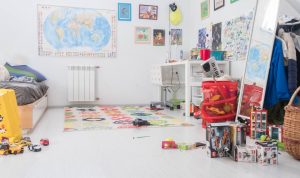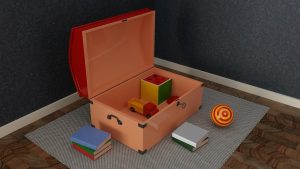Living in a household with kids undoubtedly brings joy, laughter, and, well, a proliferation of toys. The vibrant array of dolls, trucks, and board games can quickly turn your living space into a toy wonderland. While the sight of your child immersed in play is heartwarming, the ensuing clutter can be overwhelming. Fear not, decluttering your kids’ toys is not just about regaining control over your space; it’s a strategic move to foster an environment conducive to your child’s growth and well-being.
Why declutter your kids’ toys?
Decluttering your kids’ toys goes beyond a mere aesthetic transformation; it brings forth a myriad of profound benefits. Firstly, it liberates physical space, creating an environment conducive to purposeful and imaginative play. By decluttering, you pave the way for an organized space where every toy serves a purpose, fostering independence and encouraging your child’s creativity to flourish during playtime.

A decluttered space also translates into practical advantages. It facilitates easy access to toys, eliminating the frustration of searching through a chaotic array of items. This accessibility not only empowers your child to make independent choices but also streamlines playtime, making it more enjoyable and less stressful.
Moreover, the decluttering process itself serves as a valuable lesson for your child. As they rediscover forgotten toys, they learn the importance of appreciating their possessions. It becomes an opportunity to instill values such as gratitude and mindfulness, teaching them that each toy holds significance and contributes to their overall well-being.
The reduction of clutter isn’t just about visual appeal; it significantly impacts your daily routine. A well-organized space translates into less time spent navigating through a sea of toys and more quality moments shared with your child. It enhances the overall functionality of your living space, transforming it into an area where both you and your child can enjoy meaningful interactions without the constant distraction of excessive toys.
Will decluttering hurt your kid?
The natural concern that decluttering might upset your child arises from the emotional attachment they develop to their playthings. However, this concern should not serve as a deterrent but rather as an opportunity for growth and learning. Embrace the decluttering process as a chance to impart essential life lessons.
One of the primary lessons is teaching your child about letting go. Encourage them to understand that decluttering their toys doesn’t diminish their value; instead, it makes room for new experiences and memories. It’s an introduction to the concept of impermanence, showing that change can lead to positive outcomes and new opportunities for enjoyment.
Additionally, decluttering provides a valuable lesson about sharing with others. By donating toys to those in need or passing them along to friends, your child learns the joy of giving and the importance of contributing to the well-being of others. Approach the idea of decluttering with positivity, involving your child in decision-making within reasonable bounds. Assure them that the goal is not just a cleaner space but a more enjoyable, organized, and functional play area that enhances their overall experience.
Tips for decluttering kids’ toys in your home

- Schedule Purposeful Decluttering Time: Dedicate specific hours to the task, preventing procrastination and ensuring focused effort.
- Strategize Storage: Plan where the organized toys will reside. Consider practical solutions like IKEA’s Kallax shelves for efficient storage.
- Kid-Free Decluttering: Maintain focus by keeping children away during the decluttering process. Minimize impulsive decisions for a more efficient cleanup.
- Entertaining Distractions: Make the decluttering process enjoyable by playing a show, listening to a podcast, or engaging in other entertaining distractions.
- Embrace the Toy Avalanche: Overcome initial inertia by tipping all toys out, committing to sorting them out, and maintaining momentum.
- Five-Tier Sorting Strategy: Categorize toys into Keep, Store, Sell, Donate, Recycle, and Bin. Streamline the decision-making process.
- Reuniting Toy Sets: Rediscover completeness during decluttering by ensuring toys that belong together are put back in sets.
- Age-Categorized Sorting: Especially relevant for households with multiple children, sort toys by age to identify items that may have been outgrown.
- Cash In on Decluttering: Before events like Christmas or birthdays, capitalize on the opportunity to sell items that are no longer needed.
- Give with Purpose: Donate toys to friends, family, charities, or your child’s school, ensuring they find a meaningful new home.
- Embrace Toy Rotation: Keep a limited number of toy sets accessible and store the rest, rotating them every week or two to keep playtime engaging.
- Regular Decluttering Routine: Establish a consistent schedule for decluttering to adapt to your child’s evolving preferences and maintain an organized space.
How to keep your home decluttered
The journey toward maintaining a decluttered home extends beyond the initial cleanup. Employ the following strategies to ensure a consistently organized living space:
Invest in thoughtful toy storage solutions
Practical storage solutions, such as bins, baskets, and shelves, play a crucial role in maintaining a clutter-free environment. Invest in these organizational tools to categorize and store toys effectively. Consider implementing labeled bins for specific toy categories, making it easy for both you and your child to locate and return items to their designated spaces.
Establish daily cleanup routines
Encourage your child to actively participate in a quick cleanup routine at the end of each day. By making this a regular practice, you instill a sense of responsibility and organization in your child. This daily habit not only keeps the space tidy but also contributes to your child’s understanding of the importance of maintaining a clean and organized living area.
Educate your child on organization
Teaching your child about the significance of organization goes beyond daily cleanup routines. Foster a love for a tidy space by involving your child in the process of arranging and organizing their toys. Describe how creating a sense of pride in one’s surroundings through organization makes living a better experience. This educational approach reinforces the value of order and cleanliness.
Implement thoughtful toy rotation
To prevent boredom and promote sustained interest, consider implementing a thoughtful toy rotation system. Continuously rotate the toys that are accessible to your child, keeping the play experience fresh and engaging. Store additional toys in a designated space, whether it be in the attic, garage, or on a high shelf, and switch them out every week or two. This not only maximizes the use of existing toys but also introduces a sense of novelty, sparking renewed interest during playtime.
Consistency is key to maintaining a decluttered home. By incorporating these strategies into your routine, you create an environment that not only stays organized but also enhances your child’s overall living experience.
It’s important to declutter your home
Decluttering your kids’ toys is not just a task; it’s a mindful investment in your child’s well-being and development. The benefits of a clutter-free space extend far beyond the visual appeal. By creating an organized environment, you’re providing your child with the freedom to explore, learn, and grow.
Remember, the decluttering process is a journey, not a destination. Regularly revisiting and refining your approach ensures a harmonious living space for both you and your child. So, embrace the decluttering journey, savor the organized results, and watch as your home transforms into a haven of creativity, joy, and shared memories.

